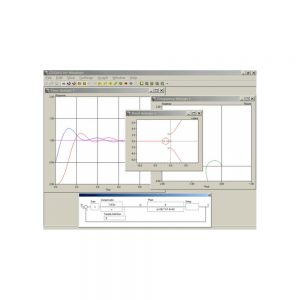Educational Products
Showing 10–12 of 12 results
-
Educational Carts
Robotic Cart for Education with GP8 Robot
The Motoman GP8 fenceless cart for education is a big solution for small spaces.
Custom designed for educational use the mobile cart includes all the components to set up an industrial robotic classroom workstation and can be packed, moved and stored easily when not in use.
The fenceless design and speed limiting of the robotic arm ensure a safe working environment for students to learn in. The platform and accessories provide a framework for learning that is simple, easy to use and packed with features and functionality for every robotics class. Incorporating the GP8, 6-axis robotic arm with an 8 kg (17.64 lbs) payload and 727 mm (28.62”) reach. students can program and learn a variety of robotic functions. The GP8 is paired with the advanced YRC1000micro controller, a compact size controller with functions & performance optimized for transfer and assembly applications. The system can be paired with a standard programming pendant or the Yaskawa Smart Pendant. The cart package includes sofware, educational resources and training from Yaskawa.
Standard features
-
- Compact, mobile with collapsible wings to fit through any lab door.
- Fenceless cart design
• Safe working/learning environment
• Allows better viewing and access compared to fully enclosed carts.
• Area scanner deployed to provide safe zone - Everything you need is included and on the cart.
- 24VDC Gripper – no compressor required
• Gripper includes open/close sensors and a LED pointer. - Durable work surface with precision markings for a range of exercises including
• Palletizing, depalletizing
• Pick and place
• Tool path and spline shape tracing - Fold out work surface allows for more working area and compact storage.
- Solid extruded aluminium construction with castors
- Easy set-up – Only one cable required
(0 reviews) -
-
E-Learning/Modules
Robotics Engineering Curriculum (REC)
Everything you need to begin a successful program aligned to national STEM standards – just add students!
REC delivers comprehensive instruction aligned to national STEM standards via hands-on activities and compelling online curriculum, all centered on three core features:
-
- LearnMate curriculum with Learning Management System (LMS)
- VEX Coding Studio (VCS) Robotic Programming Software
- Robust VEX® V5 Robotics Hardware
(0 reviews) -
-
E-Learning/Modules
WinCODAS
WinCODAS is an application for Control System Design using a Multiple Document Interface (MDI) which allows an arbitrary number of child windows to be created. In each child window the behaviour of a system may be examined in different ways. WinCODAS allows time and frequency responses to be drawn. There is a root domain where root-loci may be plotted either in the s-plane or z-plane.
Nonlinearities may be defined in a flexible and simple manner and their characteristics drawn. These nonlinearities can then be included into the control loop simulation. Time domain responses may be drawn as phase-plane diagrams. A wide range of cost-functions may be defined, settling time, integral of error squared. The cost-functions are evaluated automatically when a response is produced. The frequency domain supports direct and inverse Nyquist diagrams, Bode gain and phase plots and Nichols plots. Closed-loop gain contours (M-contours) may also be drawn. The root domain shows the open-loop poles and zeros of the system and draws root-loci for continuous-time systems with or without transport delay and discrete-time systems. Damping-ratio or Jury contours may be superimposed on a root locus diagram. For rational transfer functions, the positions of all the closed-loop poles may be displayed in a table and marked on the root locus plot.
A digitised cursor is available in all domains to obtain details of data on any plot. The cursor can be switched from absolute to relative mode to allow relative measurements such as peak overshoots or the period of an oscillatory response. There is an auto-scale function and a zoom feature that allows users to magnify any section of a plot. Each child window can have multiple plots; none of which are lost when the window is resized. The system transfer functions are entered in “free-format”. Continuous-time, discrete time and sampled-data systems may be simulated by defining the appropriate transfer function and sample hold time. There are several mapping tools that allow the user to transform transfer functions into explicit z-domain representations including: zero-order hold z-transform, rectangular rule, Tustin’s rule with pre-warping and there are a number of manipulation tools for changing the presentation of the transfer functions into Bode form, pole/zero form. The simulated system is shown graphically in a separate window and its configuration can be different for each child window. As a child window is brought into focus, the system graphic changes dynamically and so the user knows the precise nature of the system being simulated. The general system includes an overall system gain, two transfer functions, a transport delay, two nonlinearities and a zero-order hold. These elements can be included or excluded. There are three possible inputs to the system. In this way the regulation behaviour due to load disturbances and measurement noise can be simulated as well as the performance with more standard set-point or reference inputs.
Key Features
- Free-format transfer functions
- Compensator, Plant
- Transport delay
- Two nonlinearities
- Continuous Time, Sample-data, Discrete time
- Expression evaluator
- Global parameters
- Dynamic system definition schematic
- Measurement noise, Load disturbances
- Transfer-function manipulation tools
(0 reviews)



